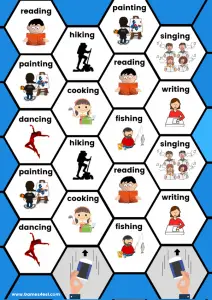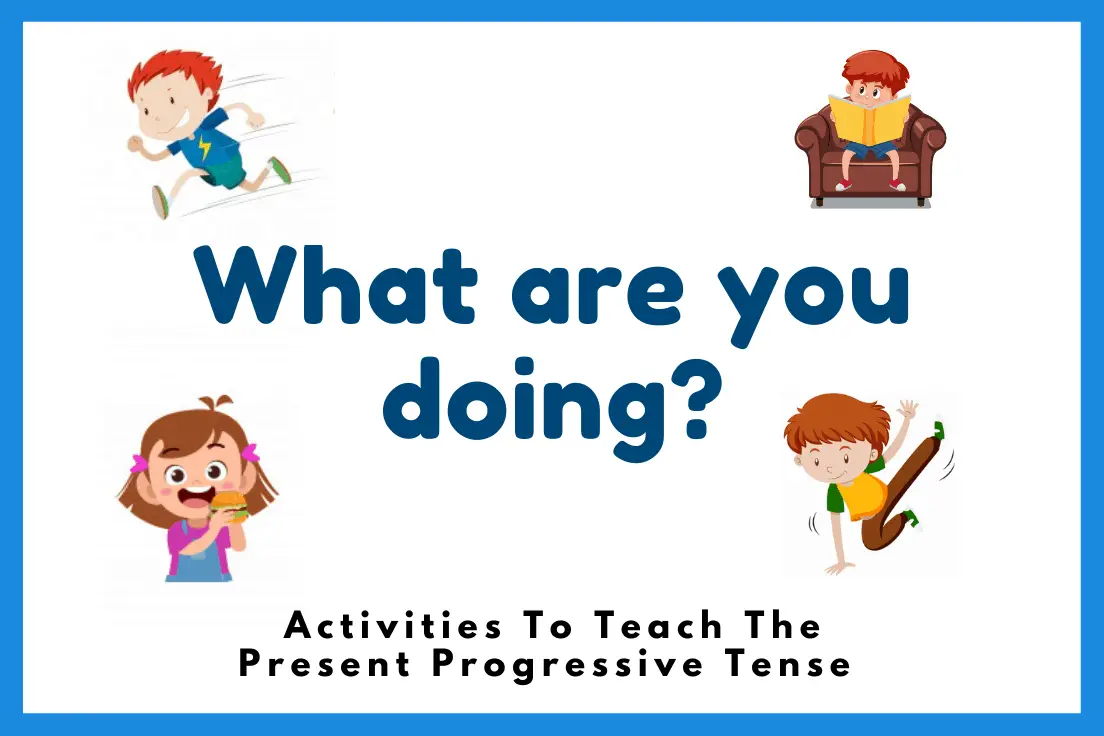What Are You Doing? | 5 Fun Activities To Teach Present Progressive Tense
Teaching the present progressive tense / present continuous tense to kids and beginner ESL learners can be incredibly fun. The present progressive tense is used to talk about a continuing action that is taking place now. For example,
- ‘What are you doing?’ – ‘I am eating a sandwich.’
- ‘What is he/she doing?’ – ‘He/She is dancing.’
- ‘What are they doing?’ – ‘They are playing soccer.’
This post includes five super fun ESL games and activities to teach the present progressive tense to beginner English language learners.
Games To Teach The Present Progressive Tense / Present Continuous Tense
1: What Are You Doing? – Charades
Charades is a perfect activity to teach the present progressive tense. If you’re not familiar with charades, it is a game where one person acts out the word/answer without speaking. The other people try to guess what it is.
This is great for teaching ‘What are you doing?’ / ‘What is he/she doing?’ as students must do an action, and the other students can guess what they are doing.
For this game, you will need some present progressive tense flashcards, or you can simply write many present progressive words on small pieces of paper.
HOW TO PLAY
Divide the class into two teams (or more if you have a large class). Then, invite one student from one of the teams to come to the front of the class. This student then has 30 seconds to act out the present progressive words while the other students in his team guess what it is.
When students are ready, start the 30-second timer and show the student one of the flashcards/words. This student will then act out the word. As the student is acting out the word, ask his/her teammates, ‘What’s he/she doing?’. As they guess, they should answer, ‘He/She is (dancing).’
When they guess correctly, show the next word for the student to act out. After 30 seconds, check how many words they guessed correctly. Then it’s the other team’s turn. The team that guesses the most words correctly is the winner.
2: ‘What Are You Doing?’ – Guessing Game
Once students have been shown how to make present progressive sentences, this guessing game is a great way to practice. This activity is a ‘Hidden Picture’ style game in which students must guess what action the picture is depicting as it is slowly revealed.
HOW TO PLAY
Play the video in class. There are ten questions. Each question asks ‘What is he doing?’, ‘What is she doing?’, or ‘What are they doing?’.
After each question, students are shown a picture that is hidden behind some colored shapes. As the shapes slowly disappear, students must guess what he/she is doing in the picture.
When students guess, encourage them to answer in full sentences. For example, when students are ready to guess, pause the video and ask ‘What is he doing?’, and students should answer ‘He is (swimming).
Present progressive words included in this game are swimming, eating, running, jumping, watching, listening, reading, drawing, playing, and dancing.
3: What Is Happening Now?
This simple no-prep game is a great way to get your students to speak and make present continuous sentences.
HOW TO PLAY
To play this game, students must look around the classroom / outside the classroom and describe what is happening right now using present progressive sentences.
For example, ‘He is breathing.’, ‘The wind is blowing.’, ‘The teacher is standing.’, ‘They are sitting.’, etc.
One by one, students should make a sentence, and if they repeat something already said, or they cannot make a sentence, they are out.
This a great game to increase students’ vocabulary while making present progressive sentences.
4: Present Progressive Narration
In this fun narration/role-play game, students will work in teams to write a role-play for another team to act out.
HOW TO PLAY
Put students into small groups and give them a simple situation for them to write a role play about. For example, you could tell students to write a role play about ‘lunchtime’, ‘at the supermarket’, ‘English class’, etc.
The role-play should include a narrator who describes what the people are doing in the role-play using present progressive sentences.
For example, ‘This is Chris. Chris is eating a sandwich. He is really enjoying it. Suddenly, a dog comes in and steals Chris’s sandwich. Chris is chasing the dog. Chris is running really fast but cannot catch the dog. Chris is crying.’, etc.
When students have finished writing their role play, they will read it out while another team must act out what the narrator is saying.
This is a really fun activity that encourages students to use their imagination, and they will surely make some hilarious scenarios for their classmates to act out.
5: What Are You Doing? – Board Game

In this fun printable board game, students take turns acting out the present progressive word in the game.
HOW TO PLAY
Download and print this board game and give one to each pair of students. Students will then take turns placing their eraser at the bottom of the board game and flicking it with their fingers.
If the eraser lands in an area with a present progressive word/picture in it, then the student’s partner should ask ‘What are you doing?’, and the student should answer and do the action at the same time (e.g. ‘I am dancing.’).
Board games are a great way to increase student talking time. For more present progressive tense board games, click here.
Thanks for reading. I hope you found some good game ideas to teach the present progressive/continuous tense. Before you go, check out our FREE Present Continuous Worksheets, which you can download and use in class today.


